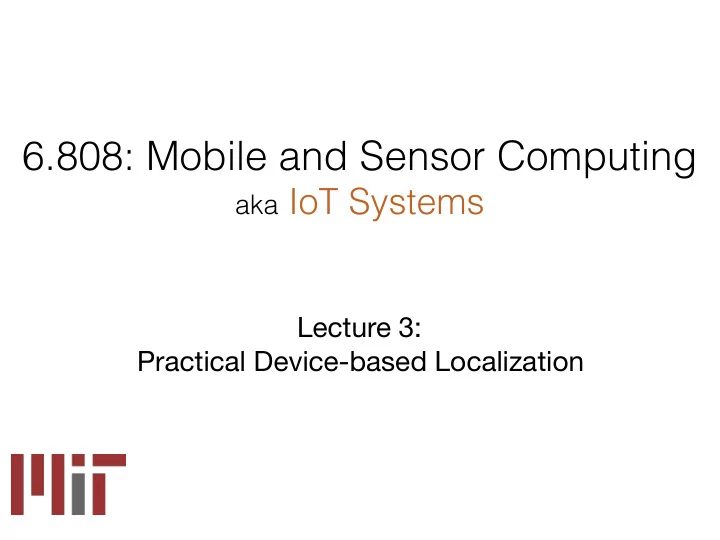

6.808: Mobile and Sensor Computing aka IoT Systems Lecture 3: Practical Device-based Localization
• Last Lecture: Localization Primitives • This Lecture: – Indoor Positioning Systems: • RADAR [2000] • Cricket [2000] – Outdoor Positioning System: • GPS
Case Study 1: RADAR [INFOCOM ’00] Why are we reading this paper? • First paper to propose using wireless LANs for indoor location estimation • Measurement-based / analysis paper (not system) • Key idea: which of the localization primitives? • Pioneering idea; with many enhancements it’s a viable approach today in many settings
• Database • Different orientations
Signal strength at the base stations as user walks
Approach • Summarize signal strength samples at base stations • Metric for determining best match • Determine “best match”
Approach • Summarize signal strength samples at base stations – Mean signal strength over a time window • Determine “best match” – Empirical method – Signal propagation model • Metric for determining best match – Nearest neighbor in signal space, i.e., Euclidean distance between ss’ and ss vectors
Evaluation • Critique the evaluation?
Averaging multiple nearest neighbors Why does the graph look like this?
Case Study 2: Cricket [MobiCom ’00] A general-purpose indoor location system for mobile and sensor computing applications
Cricket Design Goals • Must work well indoors • Must scale to large numbers of devices • Should not violate user location privacy — location-support rather than track • Must be easy to deploy and administer • Should have low energy consumption
Cricket Architecture info = “a2” Beacon info = “a1” Estimate distances to infer location Listener Passive listeners + active beacons scales well, helps preserve user privacy Decentralized, self-configuring network of autonomous beacons
SPACE = NE43-510 COORD = (146 272 0) Obtain linear distance estimates Pick nearest to infer “ space ” Solve for device ’ s (x, y, z) Determine q w.r.t. each beacon and deduce orientation vector
Determining Distance Beacon RF data (space name) Ultrasound (pulse) Listener • A beacon transmits an RF and an ultrasonic signal simultaneously – RF carries location data, ultrasound is a narrow pulse • The listener measures the time gap between the receipt of RF and ultrasonic (US) signals – Velocity of US << velocity of RF
Multiple Beacons Cause Complications Beacon A Beacon B Incorrect distance time Listener US A RF B RF A US B • Beacon transmissions are uncoordinated • Ultrasonic pulses reflect off walls These make the correlation problem hard and can lead to incorrect distance estimates Solution: Beacon interference avoidance + listener interference detection
Choosing the bitrate of transmission • How long should the packet be? • tau: 2 x ultra-sound longest TOF • packet size: S bits • bitrate < S/tau • “Long radio” • Other proposal for dealing with interference?
Localization Schemes • How to localize? • majority (pick beacon with highest freq of occurrence) • minmean (pick beacon with smallest mean distance) • minmode (pick beacon with smallest mean distance) • Other proposals? • Intrinsic Challenges? • Extending to orientation?
Case Study 3: GPS Compute the distance d 2 to the GPS satellites d 1 d 3 distance = propagation delay x speed of light 18
How to Compute the Propagation Delay? Code Each satellite has its own code 19
How to Compute the Propagation Delay? Code delay Code arrives shifted by propagation delay 20
How to Compute the Propagation Delay? delay Spike Correlation Spike determines the delay use it to compute distance and localize
GPS Data Packet • Almanac & ephemeris data • Satellite location, clock, orbital parameters, etc. • Bitrate? • 50 bits/second • Takes about 12.5 minutes to download • How do today’s systems use it? • A-GPS (Assisted GPS) • WiFi APs are mapped — war-driving 22
Summary: Device-Based Localization • Case Study 1: RADAR - first WLAN-based system - used RSSI+fingerprinting • Case Study 2: Cricket - ToF based / trilateration - new challenges with interference • Case Study 3: GPS - trilateration, A-GPS, WiFi APs Next Lecture: Device-Free Localization 23
Recommend
More recommend